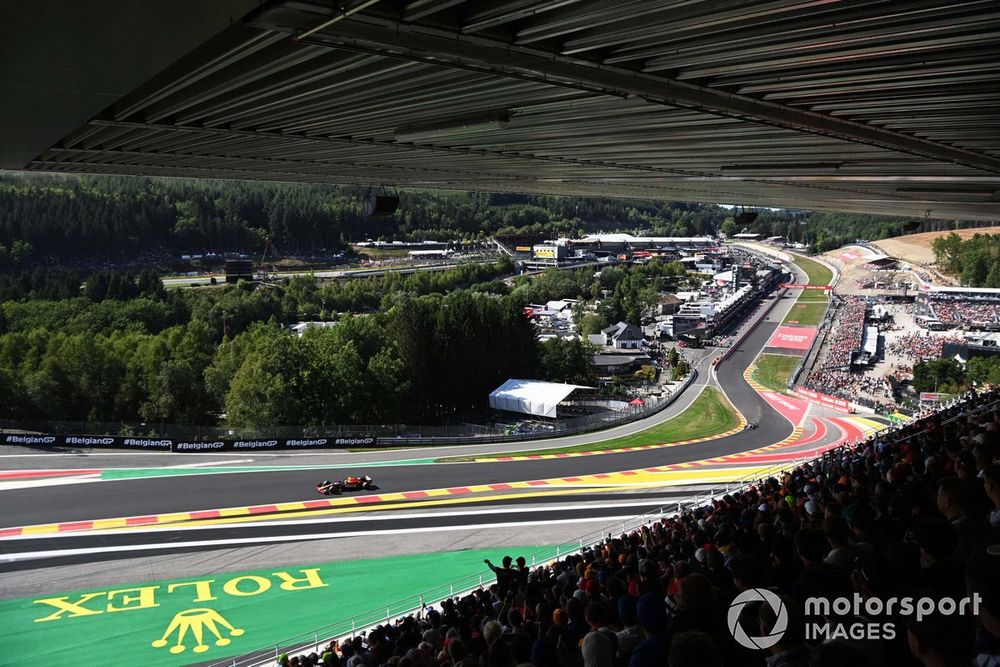
As with previous 2023 events it means that car set-up is frozen after FP1 as the field heads into qualifying, and any changes thereafter will trigger a pitlane start for the sprint and the grand prix itself.
The teams already have some experience of the new format, which was used in Azerbaijan and Austria.
However, it will be particularly challenging at Spa, where cars are especially sensitive to downforce and drag levels, as well as ride height, with the compression at Eau Rouge creating a compromise for the latter.
Usually at the Belgian venue engineers have three practice sessions during which to experiment, while eyeing the straightline speed of their immediate rivals, before settling on the best solution for qualifying.
This time they will have just a single session after which they have to make those crucial set-up calls.
If they get it wrong their cars could be out of kilter for the rest of the weekend, leaving their drivers either unable to defend on the long run up from Eau Rouge and Raidillon, or lacking speed through the corners on the rest of the track.
Teams often react to where they think their cars are likely to start, for example when those with grid penalties have erred towards less downforce and maximum straightline speed in order to help their passage through the field.
The alternative approach is to focus more on the twisty second sector, where extra downforce pays dividends.

Teams will make their lives harder by bringing new parts that they have to learn about and optimise in the single practice session. Everyone moves towards a lower drag spec for Spa, which often involves brand new wings or brake ducts tailored to the track’s requirements.
Some teams will also have general updates that they will have to learn about. For example, Alpine will have a new floor this weekend.
Spa is also only the third race with the new Pirelli tyre construction introduced at the British GP, with the harder C2 only seen previously at Silverstone, and the softest C4 only run in Hungary, and thus teams are still learning about them.
To add to the challenge, weather forecasts suggest there is a high chance of rain on Friday, which will make it even harder to make those crucial choices with an eye on the rest of the weekend, as extra downforce has obvious appeal in wet conditions.
“The biggest concern for us is a wet FP1, which often happens there over the years,” said Aston Martin performance director Tom McCullough. “Obviously we’re going a bit earlier this year before the August break.
“You're going to rely a lot on your simulation tools. We're still learning with these tyres, and you're going to go straight into a weekend when you commit to your low fuel, high fuel and wet set-up all with one session at a pretty unique track. I think we’re in reasonable shape.”
AlphaTauri chief race engineer Jonathan Eddolls points out that the Italian team has a harder task than others as new recruit Daniel Ricciardo is still learning the AT04.
“All sprint weekends are more of a challenge, it's the same for everyone,” he said. “I think you need to put more emphasis on your pre-event and simulator work. And if you've got a good simulator, you can hit the ground running.

“Obviously for Daniel, it'll be more of a challenge. He's still learning about the car. We go to a very different downforce level, and very different track, harder tyres, cooler temperatures.
“I think it's going to be a case of we will try to get the set-up as close as we can to start, and then we'll just give him the laps and tune the balance probably with aero balance through FP1.”
Eddolls acknowledges that teams often take different approaches on drag levels, and what your rivals do ends up feeding into your own choices.
“Sometimes the optimum from your simulations of your car might be different to somebody else,” he explained. “Then when you end up with a top speed delta, sometimes you need to run slightly different to what you think is your race optimum, just to be with the others.
“So for sure, the rear wing will be a story. We've got new ones coming, specific to that event. We do all we can in terms of our pre-event simulation work, looking at last year. Our approach this year to try to come up with an optimum that works for us, but that puts us in sync with the others.
“And then if we're out we'll have to change for qualifying, but that's never straightforward either.”
In theory, the restricted running should favour the teams with the best simulation tools, which inevitably means the usual top runners should be better prepared.
“The format is different,” Ferrari boss Fred Vasseur remarked. “But so far I think we did pretty well on the sprint race when you have just one FP1 before the quali, Baku and Spielberg went pretty well.
“I hope it will be the same at Spa. I think we are pretty advanced, all the teams, with the simulation. We know where we are.”





!["[T]he First and Fifth Amendments Require ICE to Provide Information About the Whereabouts of a Detained Person"](https://images.inkl.com/s3/publisher/cover/212/reason-cover.png?w=600)

